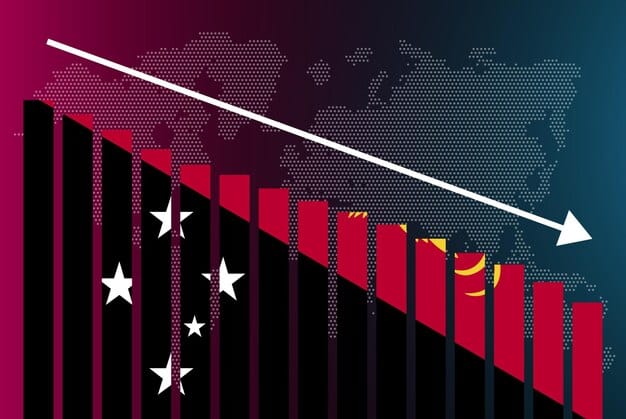US Startup Layoff Analysis: 10% Workforce Reduction & Why

A recent analysis reveals a significant workforce reduction of approximately 10% across specific US startup industries, including tech, media, and venture capital-backed firms, primarily due to economic uncertainties, overhiring during the pandemic, and a shift towards profitability over rapid growth.
The landscape of US startups is dynamic, characterized by rapid innovation and, at times, significant volatility. A critical aspect drawing considerable media attention and concern among professionals is the recent wave of layoffs. Specifically, the question often arises: US Startup Layoff Analysis: Which Industries Are Experiencing a 10% Workforce Reduction and Why? This article delves into the nuances of this trend, exploring the sectors most affected and the underlying economic, strategic, and operational factors driving these workforce adjustments.
Understanding the Current Layoff Landscape in US Startups
The past few years have presented a rollercoaster of economic conditions, impacting the growth trajectories and operational strategies of US startups. Following a period of hyper-growth fueled by abundant venture capital and a surge in digital adoption during the pandemic, many companies are now facing a recalibration. This has manifested in widespread workforce reductions, signaling a shift in priorities from aggressive expansion to sustainable profitability.
This widespread phenomenon isn’t uniform across all industries. While some sectors remain relatively insulated or even continue to expand, others are grappling with significant adjustments. Understanding which industries are most vulnerable to these 10% workforce reductions is crucial for founders, employees, and investors alike. It allows for more informed decision-making and strategic planning in a highly uncertain environment.
The Overhiring Conundrum
Many startups, particularly in the tech sector, experienced unprecedented growth during the pandemic, leading to a hiring spree. The demand for digital services soared, and companies scaled up their teams envisioning continued exponential growth. However, as the world normalized and economic headwinds emerged, this rapid expansion proved unsustainable.
This overhiring created bloated workforces, leading to inefficiencies and increased burn rates. When the market shifted, these companies found themselves with expenses that outpaced their revenue growth, necessitating tough decisions like workforce reductions. The 10% layoff figure often represents an initial, strategic correction to bring headcount back in line with current and projected revenue streams.
Market Correction and Funding Shifts
Another major factor contributing to layoffs is the broader market correction. Rising interest rates, inflation, and geopolitical instabilities have led to a more cautious investment climate. Venture capital funding, while still substantial, has become more discerning. Investors are now prioritizing tangible paths to profitability over abstract growth metrics, pushing startups to cut costs and demonstrate financial viability.
This shift in investor sentiment means that securing new rounds of funding has become more challenging, especially for companies that haven’t yet achieved profitability. Without consistent capital injections, many startups are forced to trim their operational costs, with payroll often being the largest expenditure. The 10% reduction often serves as a signal to investors that the company is serious about fiscal responsibility.
For many emerging companies, the past decade was defined by growth at all costs, funded by an eager venture capital ecosystem. This paradigm began to shift in late 2022 and accelerated through 2023, as interest rates climbed and the cost of capital increased. Investment firms became more conservative, demanding clear runways to profitability and sustainable business models. This pivot forced many startups to re-evaluate their financial health and aggressively cut spending where possible.
The impact of this funding shift is particularly noticeable in companies that previously relied heavily on large, successive funding rounds to fuel their expansion. Without the consistent influx of capital, operational budgets tighten, and the most immediate way to reduce costs often comes through workforce adjustments. This economic pressure contributes significantly to the 10% reduction figures observed across various sectors.
Industries Most Affected by 10% Layoffs
While layoffs have touched various sectors, some industries have borne the brunt of these workforce reductions more acutely than others. Identifying these industries helps to provide a clearer picture of the economic stressors at play.
Technology (Software, SaaS, E-commerce)
The technology sector, particularly software-as-a-service (SaaS) and e-commerce, has been at the epicenter of the layoff storm. These industries experienced unprecedented growth during the pandemic, driven by accelerated digital transformation and consumer reliance on online services. Companies rapidly expanded their teams to meet surging demand, often based on projections that did not account for a post-pandemic normalization or economic downturns.
- SaaS Companies: Many SaaS firms, especially those targeting enterprise clients, saw their sales cycles lengthen and customer churn rates increase as businesses tightened their belts. Companies like Salesforce, Microsoft (LinkedIn), and Zendesk, while not strictly startups, set a precedent for many smaller tech startups to follow suit, undergoing significant workforce reductions. The focus shifted from acquiring new users at any cost to retaining existing ones and improving product efficiency.
- E-commerce Platforms: E-commerce startups, which thrived amidst lockdowns, are now contending with consumers returning to brick-and-mortar stores and a general slowdown in discretionary spending. Companies that built large fulfillment and customer service teams are now right-sizing their operations to align with more modest growth projections. This sector often sees around a 10% reduction as consumer habits revert to pre-pandemic norms.
- Fintech: The fintech industry, which saw massive investment and innovation in recent years, is also experiencing a reckoning. Higher interest rates dampen lending activities, and increased regulatory scrutiny adds operational burdens. Fintech startups focused on lending, cryptocurrency, or speculative investments have often been hit hardest, with some undergoing multiple rounds of layoffs. The enthusiasm for crypto, for example, cooled significantly, leading to substantial cuts in firms that had rapidly expanded their workforce during the boom.
The tech industry’s rapid scaling led to a substantial increase in overhead, making it particularly susceptible to market shifts. As investment capital became scarcer and more expensive, many tech startups found themselves in a precarious position, needing to quickly reduce costs to extend their runway. The 10% threshold often represents a surgical cut aimed at eliminating duplicated roles or non-essential projects that became viable only during periods of hyper-growth.
The tech layoff trend isn’t just about economic factors; it’s also a re-evaluation of business models. Many startups in this space were built on the premise of rapid user acquisition and market share dominance, often at the expense of profit. As the market demands profitability, these companies are restructuring their operations to be leaner and more efficient. This involves not only reducing headcount but also streamlining product lines and re-prioritizing engineering efforts towards revenue-generating features. The current climate forces a more disciplined approach to resource allocation.

Factors Driving the 10% Workforce Reduction
Understanding the “why” behind these 10% workforce reductions goes beyond simple economic downturns. Several interconnected factors are contributing to this trend, creating a complex web of challenges for startup leaders.
Economic Headwinds and Recession Fears
The most overarching factor is the prevailing economic uncertainty. Rising inflation, aggressive interest rate hikes by central banks, and persistent fears of a looming recession have made consumers and businesses more cautious. This translates into reduced spending, longer sales cycles for B2B startups, and a general deceleration in economic activity. Startups, often more susceptible to market sentiment due to their reliance on growth, react by tightening their belts. A 10% reduction can be a preemptive measure to prepare for leaner times and lower projected revenues.
These economic pressures erode consumer confidence and corporate spending, creating a ripple effect across the startup ecosystem. Companies that thrived during periods of low interest rates and abundant liquidity are now facing a significantly different landscape, where capital is more expensive and growth is harder to achieve. This often necessitates strategic cuts to preserve cash and extend financial runways.
Shift from Growth-at-All-Costs to Profitability
For more than a decade, the mantra in Silicon Valley and beyond was “growth at all costs.” Startups were rewarded for scaling rapidly, even if it meant incurring significant losses, with the expectation that market dominance would eventually lead to profitability. Investors were willing to fund these losses, believing in the long-term potential.
However, that paradigm has fundamentally shifted. With a tightening capital market and public market investors demanding profitability, venture capitalists are now pushing their portfolio companies to prioritize financial sustainability. This means scrutinizing burn rates, optimizing operational efficiency, and, crucially, making sure that every employee contributes directly to the bottom line. A 10% layoff helps reduce the burn rate and signals a commitment to financial discipline, which is increasingly attractive to current and prospective investors.
This strategic pivot is not merely reactive; it’s a fundamental change in how startups are valued and managed. Companies are now encouraged to focus on unit economics, customer lifetime value, and efficient customer acquisition. This transition often means shedding roles that were central to aggressive growth strategies but do not align with a leaner, profitability-focused model. The 10% reduction is often a direct consequence of this strategic re-alignment, targeting areas identified as less critical for immediate revenue generation.
Over-Hiring and Inefficient Resource Allocation
As mentioned earlier, many startups engaged in aggressive hiring during the boom years, often anticipating a sustained trajectory of hyper-growth. This led to instances of over-hiring, where companies brought on more talent than was truly necessary or sustainable over the long term. In some cases, teams became bloated, leading to inefficiencies, redundant roles, and a dilution of individual contributions.
When the market turned, these companies had to confront the reality of their oversized headcounts. The 10% layoff often addresses this over-hiring, allowing companies to “right-size” their teams and eliminate redundant positions. It’s a painful but necessary process to optimize resource allocation, focusing talent on core functions that directly contribute to product development, sales, and customer success.
This problem isn’t always about malice; sometimes, it’s a consequence of rapid, unprecedented scaling. Companies simply couldn’t keep up with the pace of demand and brought on staff quickly to fill gaps, assuming future revenue would justify the expense. As demand normalizes, these previously justified hires become an avoidable cost. The 10% often represents positions that were either redundant, underutilized, or aligned with now-defunct growth initiatives.
Beyond the Numbers: The Human and Systemic Impact
While the statistics of 10% workforce reductions offer a quantitative measure of the startup landscape’s challenges, the human and systemic impacts are profound. These layoffs ripple through communities, affecting not only the individuals directly impacted but also the remaining workforce, company culture, and the broader economic fabric.
Employee Morale and Talent Retention
Layoffs, regardless of their scale, inevitably take a toll on employee morale. Those who remain often experience survivor’s guilt, increased workload, and anxiety about future job security. This can lead to decreased productivity, higher stress levels, and a potential exodus of top talent who seek more stable environments. Startups face the delicate challenge of maintaining a positive culture and retaining their key employees amidst such difficult transitions.
The perceived stability of a company significantly influences its ability to attract and retain talent. Frequent or large-scale layoffs can tarnish a company’s reputation as an employer, making it harder to recruit high-caliber individuals when economic conditions improve. This long-term impact on brand image can be more damaging than the immediate cost savings from layoffs.
Impact on Innovation and Startup Ecosystem
Large-scale layoffs can also have a systemic impact on innovation. When experienced talent is suddenly displaced, it can lead to a dispersal of knowledge and a slowdown in product development cycles. While some laid-off employees may go on to found new startups, the immediate effect can be a reduction in collective innovative capacity within established companies.
Furthermore, the increased cautiousness in the venture capital market, partially triggered by these economic realities, means fewer new startups are likely to receive seed funding. This could lead to a temporary contraction in the overall startup ecosystem, potentially slowing down the pace of disruptive innovation that the US has been known for. However, some argue that these periods also foster more resilient and capital-efficient new ventures.
The Role of Macroeconomic Policy
The decisions made by central banks and governments regarding interest rates, fiscal policy, and regulation play a significant role in shaping the economic environment for startups. High interest rates, for instance, increase the cost of borrowing for businesses and reduce the availability of capital for venture funds, directly impacting startups’ ability to secure funding and scale. Regulatory changes, particularly in industries like fintech, can also impose additional operational burdens, leading to workforce adjustments.
Understanding these broader policy frameworks is crucial for predicting and responding to future layoff trends. Policymakers face the challenge of balancing inflation control with promoting economic growth, a delicate act that directly influences the health and stability of the startup ecosystem.
These policy interventions create a domino effect. When borrowing becomes more expensive, consumer and business spending tends to decrease. This direct impact on demand means that many startups see their revenue models challenged, forcing them to find cost efficiencies. The 10% reduction figures are often a visible outcome of these macroeconomic shifts translating into microeconomic company decisions. This interconnectedness highlights the complex nature of the current economic environment a startup operates within.

Navigating the Challenges: Strategies for Startups
In this challenging environment, startups are adopting various strategies to mitigate the impact of economic headwinds and avoid or minimize significant workforce reductions. For those that have already undergone layoffs, the focus shifts to recovery and building a more resilient future.
Prioritizing Profitability and Efficiency
The most immediate and critical strategy is a renewed focus on profitability. This involves a rigorous analysis of all expenditure, identifying non-essential costs, and optimizing operational workflows. For many startups, this means moving away from aggressive growth metrics to demonstrating strong unit economics and a clear path to generating positive cash flow. Businesses are scrutinizing every dollar spent, from marketing campaigns to software subscriptions, ensuring a direct return on investment.
Efficiency also entails leveraging technology to automate processes and reduce manual labor where possible. This can include investing in AI tools, optimizing supply chains, and streamlining customer support operations. By becoming leaner and more agile, startups can better withstand economic shocks and reduce the likelihood of relying on further widespread layoffs.
- Cost Reduction: This isn’t just about cutting salaries; it involves a holistic review of all operational expenses. Companies are renegotiating vendor contracts, reducing office space, and optimizing cloud computing costs. Every line item in the budget is scrutinized to find opportunities for savings without crippling core operations.
- Revenue Diversification: Relying on a single revenue stream can be risky. Startups are exploring additional product lines, new markets, and different pricing models to diversify their income. This creates a stronger financial foundation that can absorb fluctuations in any single market segment.
- Focus on Core Products: During boom times, many startups expand into new, sometimes tangential, product areas. In a downturn, the focus shifts back to core offerings that generate the most revenue and align best with the company’s long-term vision. Non-core projects are often paused or cut entirely to conserve resources.
This strategic realignment is not a temporary fix but a fundamental change in how startups are managed. The emphasis on profitability and efficiency is likely to persist even when economic conditions improve, fostering a more disciplined approach to scaling and resource allocation throughout the industry. This is also attractive to investors, who are now looking for sustainable growth over aggressive expansion.
Strategic Talent Management and Reskilling
Even when layoffs are necessary, companies are trying to manage talent more strategically. This includes internal mobility programs, where employees are retrained for roles that are deemed critical for future growth. Reskilling initiatives help retain valuable institutional knowledge and demonstrate a commitment to employee development, even during challenging times.
For employees who are laid off, many companies are offering outplacement services, resume assistance, and job search support. This not only aids the impacted individuals but also helps maintain the company’s reputation and relationships within the broader talent pool. A compassionate approach to layoffs can significantly buffer the negative impact on company morale and future hiring efforts.
The ability to adapt the existing workforce to evolving business needs is becoming paramount. Instead of immediate layoffs, some companies are exploring opportunities to retrain staff for new or emerging roles, particularly those driven by technological advancements like AI or data analytics. This proactive approach to talent management can reduce the need for drastic cuts and preserve a valuable internal workforce, ensuring continuity and knowledge retention within the organization.
Future Outlook and Resilience of the Startup Ecosystem
While the current period presents undeniable challenges, the US startup ecosystem has historically demonstrated remarkable resilience and adaptability. The current wave of layoffs, though painful, could ultimately lead to a stronger, more disciplined, and more sustainable startup landscape.
A More Mature Investment Environment
The shift in investor sentiment from “growth at all costs” to “profitability and efficiency” is fostering a more mature investment environment. This could lead to more sustainable business models, reducing the likelihood of future boom-and-bust cycles. Investors are now more discerning, prioritizing companies with clear revenue models and strong unit economics, which encourages more disciplined scaling from the outset.
This maturation also implies a greater emphasis on due diligence and a longer-term view of investment returns. Rather than rapid exits, investors may seek deeper engagement with portfolio companies, providing strategic guidance to navigate challenges and build lasting value. This collaborative approach can strengthen startups from within, making them less prone to external economic shocks.
Emergence of New Opportunities
Periods of economic downturn often spark innovation and the creation of new opportunities. Laid-off talent, often highly skilled and entrepreneurial, may found new startups that are built with efficiency and profitability in mind from day one. These “phoenix” startups could emerge stronger, leveraging lessons learned from previous market cycles.
Furthermore, the challenges themselves create opportunities for companies offering solutions to these problems, such as cost-optimization software, efficiency tools, and specialized consulting services. The market dynamics are shifting, but innovation remains at the core of the startup spirit, paving the way for new ventures and evolving business models.
Long-Term Health and Sustainability
Ultimately, the current period of adjustment is likely a necessary step towards a healthier and more sustainable startup ecosystem. Companies that survive this period will likely be those with robust business models, strong financial discipline, and a clear understanding of their market value. This period of market correction, while difficult, can weed out unsustainable ventures and pave the way for more resilient and impactful businesses to thrive in the long run.
The lessons learned from this cycle of over-hiring and subsequent layoffs will likely reshape future hiring practices, emphasizing thoughtful expansion over rapid, unsustainable growth. This enhanced focus on strategic growth and careful resource management bodes well for the long-term health and stability of the US startup landscape, ensuring that future expansions are built on more solid financial foundations.
| Key Point | Brief Description |
|---|---|
| 📉 Tech Layoffs | Software, SaaS, and E-commerce are heavily impacted, shedding staff after overhiring during the pandemic boom. |
| 💰 Funding Shift | Venture capital now prioritizes profitability over rapid growth, leading startups to cut costs. |
| 📈 Economic Headwinds | Inflation, interest rate hikes, and recession fears force startups to right-size workforces. |
| 💡 Resilience Ahead | Though challenging, current adjustments foster a leaner, more sustainable US startup ecosystem. |
Frequently Asked Questions About US Startup Layoffs
The technology sector, encompassing software (SaaS), e-commerce platforms, and fintech, is experiencing the most significant impact. These industries often saw rapid expansion during the pandemic, leading to overhiring that is now being corrected due to economic shifts and a renewed focus on profitability by investors.
Key drivers include broader economic headwinds such as inflation and rising interest rates, a fundamental shift in venture capital funding towards profitability over growth at all costs, and previous over-hiring practices that made companies financially unsustainable when market conditions changed. Startups are prioritizing efficiency and extending financial runways.
A 10% layoff, while aiming to reduce costs, can significantly affect employee morale, increase workload for remaining staff, and potentially lead to top talent attrition. It demands careful communication and strategic talent management to preserve culture and productivity. The goal is to emerge leaner but still effective.
While challenging, these layoffs are generally seen as a market correction rather than a sign of systemic failure. The US startup ecosystem is resilient, and these adjustments often lead to more disciplined, efficient, and sustainable business models. It encourages a focus on generating real value and profitability from day one.
Startups are prioritizing profitability through rigorous cost analysis and operational efficiency improvements. Many are also focusing on strategic talent management, including reskilling programs for existing employees and offering support to those affected by layoffs. The aim is to build more resilient and sustainable companies.
Conclusion
The recent wave of workforce reductions, particularly the approximate 10% layoffs observed across key US startup industries like technology, is a clear indicator of a significant shift in the economic landscape. Driven by macroeconomic pressures, a reorientation of venture capital priorities towards profitability, and a necessary correction from pandemic-era over-hiring, these changes, while painful in the short term, are reshaping the ecosystem. This period of recalibration is pushing startups towards more sustainable and efficient business models, fostering a more disciplined approach to growth. The resilience of the US startup scene suggests that while challenging, these adjustments may ultimately lead to a healthier and more mature industry, better equipped to face future economic fluctuations and continue driving innovation.





